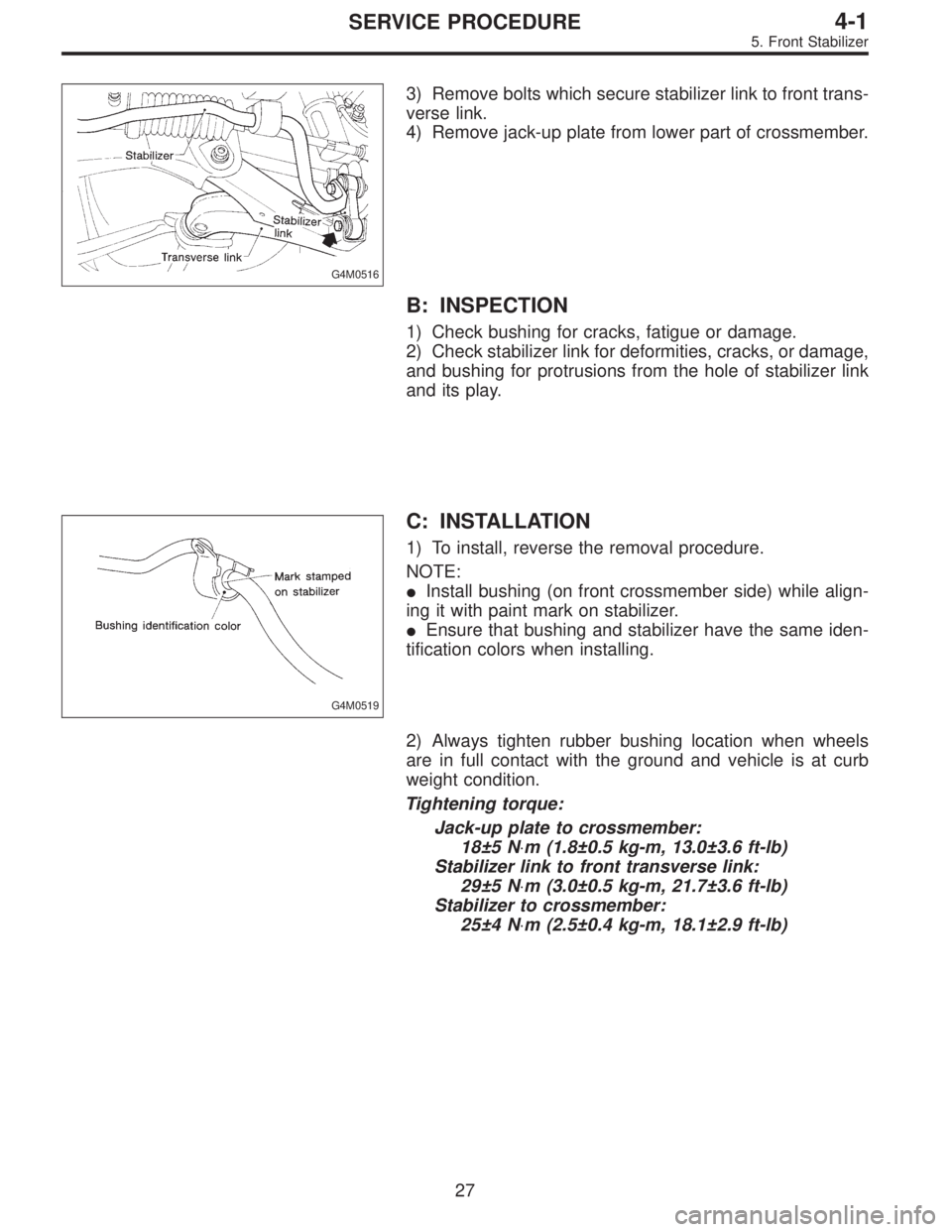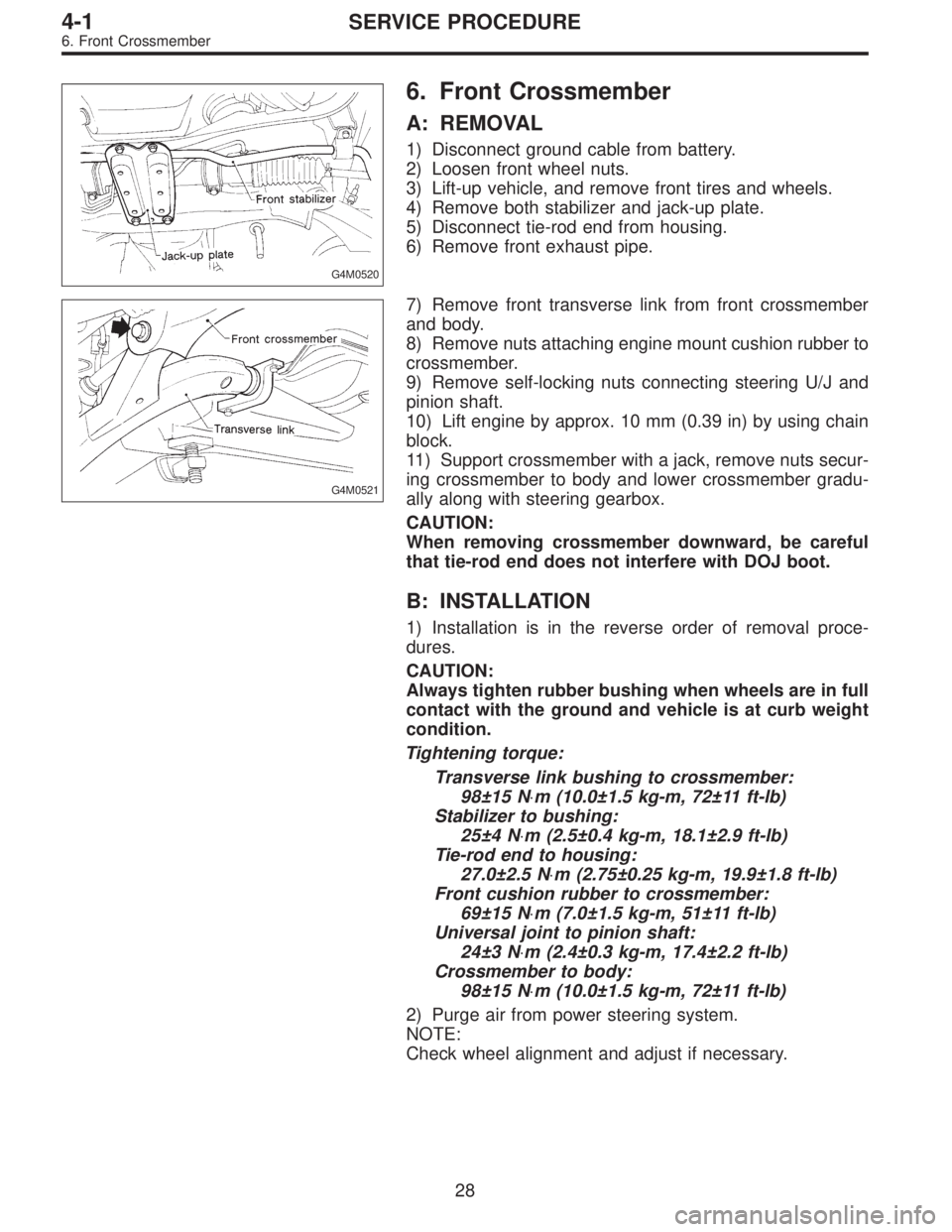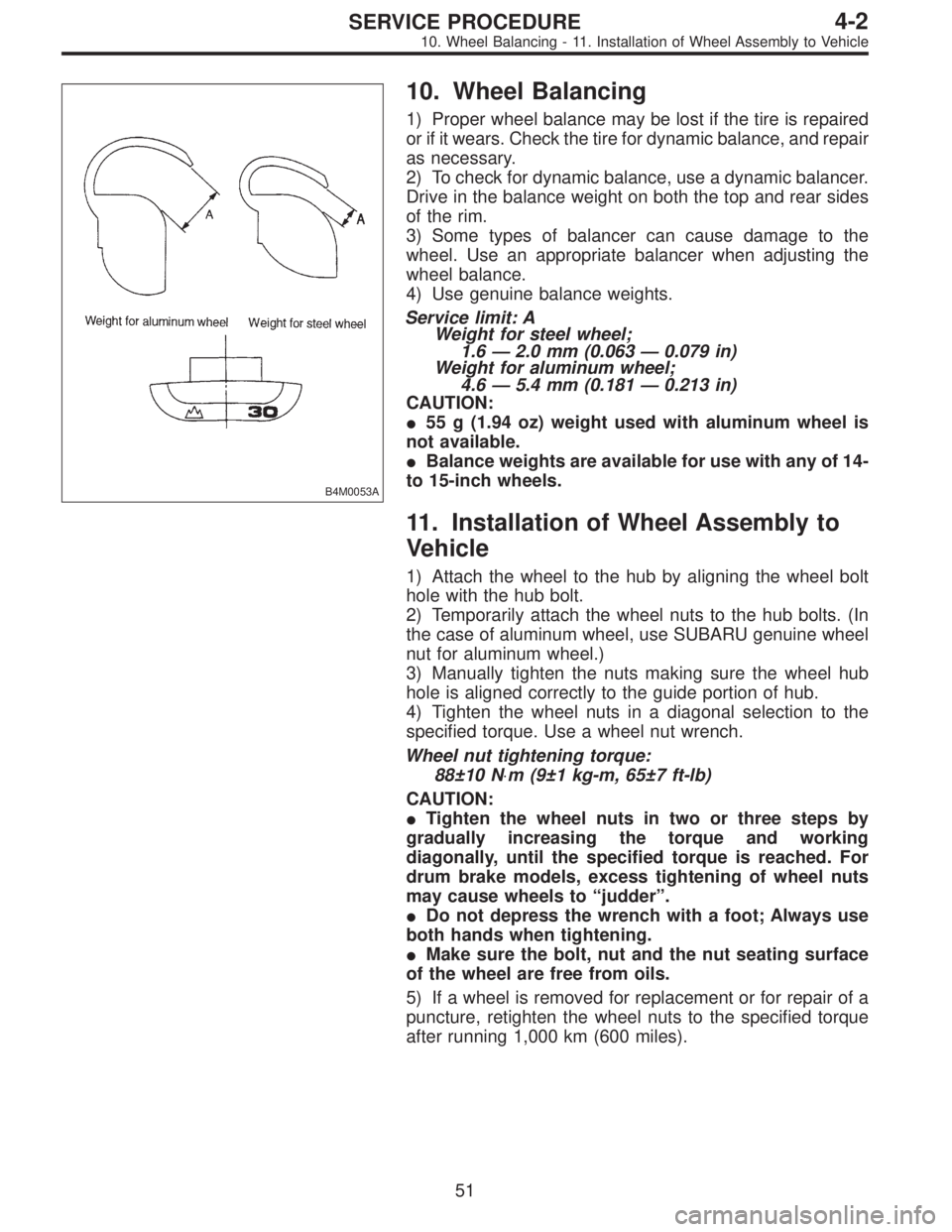Page 1028 of 2890

G4M0516
3) Remove bolts which secure stabilizer link to front trans-
verse link.
4) Remove jack-up plate from lower part of crossmember.
B: INSPECTION
1) Check bushing for cracks, fatigue or damage.
2) Check stabilizer link for deformities, cracks, or damage,
and bushing for protrusions from the hole of stabilizer link
and its play.
G4M0519
C: INSTALLATION
1) To install, reverse the removal procedure.
NOTE:
�Install bushing (on front crossmember side) while align-
ing it with paint mark on stabilizer.
�Ensure that bushing and stabilizer have the same iden-
tification colors when installing.
2) Always tighten rubber bushing location when wheels
are in full contact with the ground and vehicle is at curb
weight condition.
Tightening torque:
Jack-up plate to crossmember:
18±5 N⋅m (1.8±0.5 kg-m, 13.0±3.6 ft-lb)
Stabilizer link to front transverse link:
29±5 N⋅m (3.0±0.5 kg-m, 21.7±3.6 ft-lb)
Stabilizer to crossmember:
25±4 N⋅m (2.5±0.4 kg-m, 18.1±2.9 ft-lb)
27
4-1SERVICE PROCEDURE
5. Front Stabilizer
Page 1029 of 2890

G4M0520
6. Front Crossmember
A: REMOVAL
1) Disconnect ground cable from battery.
2) Loosen front wheel nuts.
3) Lift-up vehicle, and remove front tires and wheels.
4) Remove both stabilizer and jack-up plate.
5) Disconnect tie-rod end from housing.
6) Remove front exhaust pipe.
G4M0521
7) Remove front transverse link from front crossmember
and body.
8) Remove nuts attaching engine mount cushion rubber to
crossmember.
9) Remove self-locking nuts connecting steering U/J and
pinion shaft.
10) Lift engine by approx. 10 mm (0.39 in) by using chain
block.
11) Support crossmember with a jack, remove nuts secur-
ing crossmember to body and lower crossmember gradu-
ally along with steering gearbox.
CAUTION:
When removing crossmember downward, be careful
that tie-rod end does not interfere with DOJ boot.
B: INSTALLATION
1) Installation is in the reverse order of removal proce-
dures.
CAUTION:
Always tighten rubber bushing when wheels are in full
contact with the ground and vehicle is at curb weight
condition.
Tightening torque:
Transverse link bushing to crossmember:
98±15 N⋅m (10.0±1.5 kg-m, 72±11 ft-lb)
Stabilizer to bushing:
25±4 N⋅m (2.5±0.4 kg-m, 18.1±2.9 ft-lb)
Tie-rod end to housing:
27.0±2.5 N⋅m (2.75±0.25 kg-m, 19.9±1.8 ft-lb)
Front cushion rubber to crossmember:
69±15 N⋅m (7.0±1.5 kg-m, 51±11 ft-lb)
Universal joint to pinion shaft:
24±3 N⋅m (2.4±0.3 kg-m, 17.4±2.2 ft-lb)
Crossmember to body:
98±15 N⋅m (10.0±1.5 kg-m, 72±11 ft-lb)
2) Purge air from power steering system.
NOTE:
Check wheel alignment and adjust if necessary.
28
4-1SERVICE PROCEDURE
6. Front Crossmember
Page 1034 of 2890
B4M0196A
3) Turn trailing link upside down. Press ST plunger in the
direction opposite that outlined in step 2) until bushing is
correctly positioned in trailing link.
ST 927730000 INSTALLER & REMOVER SET
E: INSTALLATION
Installation is in the reverse order of removal.
CAUTION:
Always tighten rubber bushing location when wheels
are in full contact with the ground and vehicle is at
curb weight condition.
NOTE:
Check wheel alignment and adjust if necessary.
33
4-1SERVICE PROCEDURE
7. Rear Trailing Link
Page 1040 of 2890
E: INSTALLATION
To install, reverse removal procedures, reading the follow-
ing instructions.
CAUTION:
�Always tighten rubber bushing when wheels are in
full contact with the ground and vehicle is at curb
weight condition.
�Tighten nut when installing adjusting bolt.
�Replace self-locking nut and DOJ circlip with new
ones.
NOTE:
�Lateral link washers for FWD and AWD models can be
identified by colors, as follows:
Olive (FWD model)
Gold (AWD model)
�Check wheel alignment and adjust if necessary.
39
4-1SERVICE PROCEDURE
8. Lateral Link
Page 1045 of 2890
B: INSPECTION
Check removed parts for wear, damage and cracks, and
correct or replace if defective.
C: INSTALLATION
Installation is in reverse order of removal procedure.
CAUTION:
�Discard loosened self-locking nut and replace with a
new one.
�Always tighten nut (not adjusting bolt), when tight-
ening adjusting bolt.
�Always tighten rubber bushing when wheels are in
full contact with the ground and vehicle is at curb
weight condition.
NOTE:
Check wheel alignment and adjust if necessary.
44
4-1SERVICE PROCEDURE
10. Rear Crossmember (FWD Model)
Page 1047 of 2890
G4M0544
5) Place transmission jack under rear crossmember.
G4M0545
6) Remove bolts securing crossmember to vehicle body,
and remove crossmember.
7) Scribe an alignment mark on rear lateral link cam bolt
and crossmember.
8) Remove four bolts securing front and rear lateral links
to crossmember by loosening nuts.
B: INSPECTION
Check removed parts for damage and cracks, and correct
or replace if defective.
C: INSTALLATION
1) Install in reverse order of removal.
2) For installation and tightening torque of rear differential,
refer to 3-4 [W2F0].
CAUTION:
Always tighten rubber bushing when wheels are in full
contact with the ground and vehicle is at curb weight
condition.
NOTE:
Check wheel alignment and adjust if necessary.
46
4-1SERVICE PROCEDURE
11. Rear Crossmember (AWD Model)
Page 1051 of 2890
5. APPLICATION TABLE
Model Power unitFront drive shaft
Rear drive shaft
5MT 4AT
FWD 2200 cc 95AC-DOJ 87AC-DOJ—
AWD 2200 cc 87AC-DOJ 87AC-DOJ 79AC-RH, 79AC-LH
AWD 2500 cc—87AC-FTJ 79AC-RH, 79AC-LH
B: SERVICE DATA
Wheel balancing Standard Service limit
Dynamic unbalance Less than 5 g (0.18 oz)
Balance weight part number
(For steel wheel)Weight g (oz)
28101AA001 5 (0.18)
28101AA011 10 (0.35)
28101AA021 15 (0.53)
28101AA031 20 (0.71)
28101AA041 25 (0.88)
28101AA051 30 (1.06)
28101AA061 35 (1.23)
28101AA071 40 (1.41)
28101AA081 45 (1.59)
28101AA091 50 (1.76)
28101AA101 55 (1.94)
28101AA111 60 (2.12)
Balance weight part number
(For aluminum wheel)Weight g (oz)
23141GA462 5 (0.18)
23141GA472 10 (0.35)
23141GA482 15 (0.53)
23141GA492 20 (0.71)
23141GA502 25 (0.88)
23141GA512 30 (1.06)
23141GA522 35 (1.23)
23141GA532 40 (1.41)
23141GA542 45 (1.59)
23141GA552 50 (1.76)
—55 (1.94)
23141GA572 60 (2.12)
4
4-2SPECIFICATIONS AND SERVICE DATA
1. Wheels and Axles
Page 1103 of 2890

B4M0053A
10. Wheel Balancing
1) Proper wheel balance may be lost if the tire is repaired
or if it wears. Check the tire for dynamic balance, and repair
as necessary.
2) To check for dynamic balance, use a dynamic balancer.
Drive in the balance weight on both the top and rear sides
of the rim.
3) Some types of balancer can cause damage to the
wheel. Use an appropriate balancer when adjusting the
wheel balance.
4) Use genuine balance weights.
Service limit: A
Weight for steel wheel;
1.6—2.0 mm (0.063—0.079 in)
Weight for aluminum wheel;
4.6—5.4 mm (0.181—0.213 in)
CAUTION:
�55 g (1.94 oz) weight used with aluminum wheel is
not available.
�Balance weights are available for use with any of 14-
to 15-inch wheels.
11. Installation of Wheel Assembly to
Vehicle
1) Attach the wheel to the hub by aligning the wheel bolt
hole with the hub bolt.
2) Temporarily attach the wheel nuts to the hub bolts. (In
the case of aluminum wheel, use SUBARU genuine wheel
nut for aluminum wheel.)
3) Manually tighten the nuts making sure the wheel hub
hole is aligned correctly to the guide portion of hub.
4) Tighten the wheel nuts in a diagonal selection to the
specified torque. Use a wheel nut wrench.
Wheel nut tightening torque:
88±10 N⋅m (9±1 kg-m, 65±7 ft-lb)
CAUTION:
�Tighten the wheel nuts in two or three steps by
gradually increasing the torque and working
diagonally, until the specified torque is reached. For
drum brake models, excess tightening of wheel nuts
may cause wheels to “judder”.
�Do not depress the wrench with a foot; Always use
both hands when tightening.
�Make sure the bolt, nut and the nut seating surface
of the wheel are free from oils.
5) If a wheel is removed for replacement or for repair of a
puncture, retighten the wheel nuts to the specified torque
after running 1,000 km (600 miles).
51
4-2SERVICE PROCEDURE
10. Wheel Balancing - 11. Installation of Wheel Assembly to Vehicle